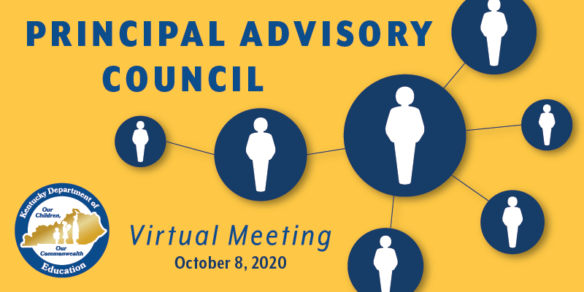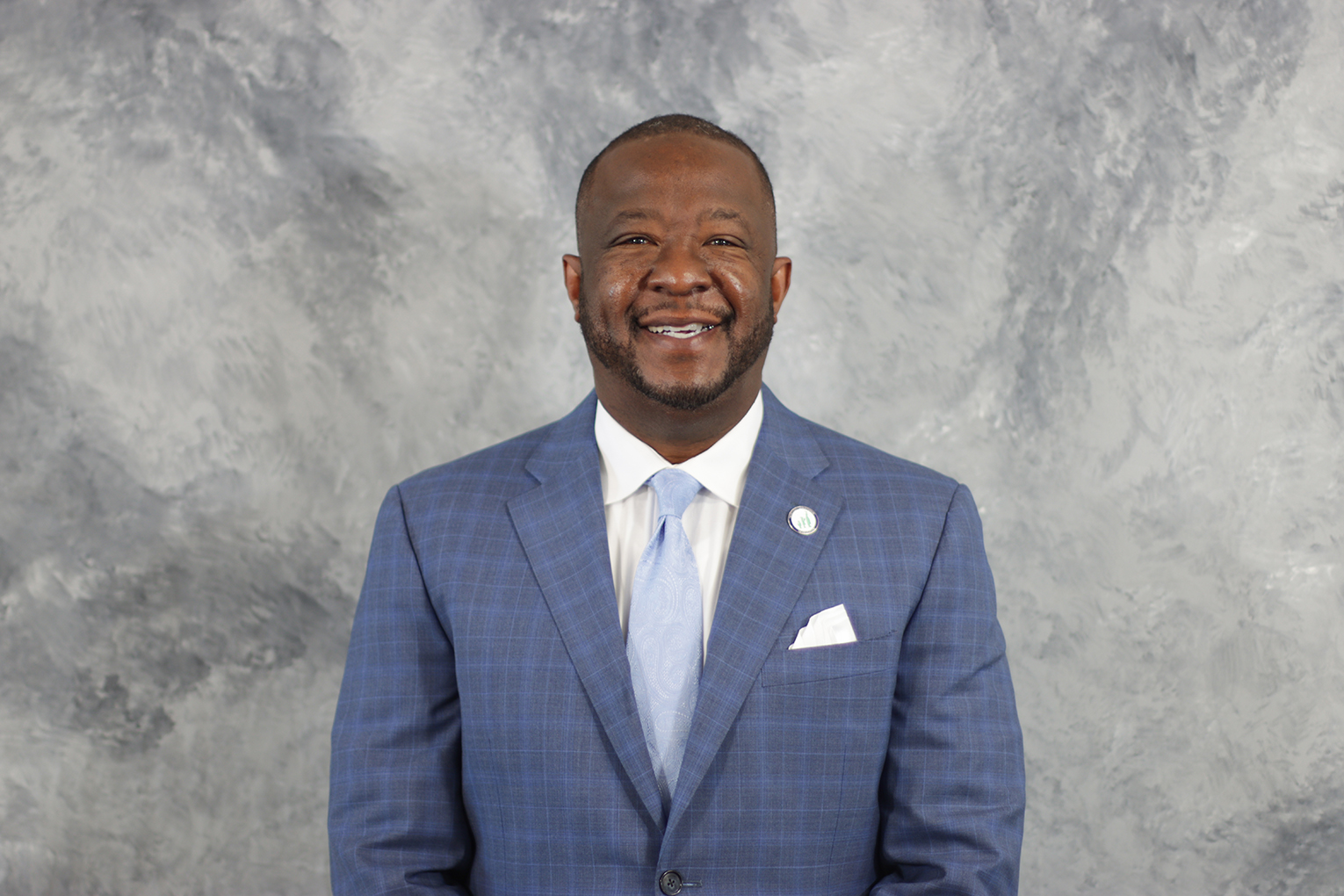
- Glass discussed his plans as the Commonwealth’s new commissioner of education.
- Throughout the pandemic, school staff have had no choice but to leave their comfort zone and grow as educators, said Lester Diaz, principal at Frederick Douglass High School (Fayette County).
By Jacob Perkins
Jacob.perkins@education.ky.gov
Kentucky’s Education Commissioner and Chief Learner Jason E. Glass was introduced to the Principal Advisory Council (PrAC) during its first-quarter meeting on Oct. 8.
He began the meeting by individually addressing each member to learn more about their school and reopening plans.
Most of the principals on the council said their schools are still operating virtually. Others, like Michelle Ritchie Curtis, principal of Perry Central High School (Perry County), said their schools initially opened with a hybrid model – a combination of both in-person and virtual instruction – but have since gone completely virtual.
“It has been a very interesting year,” Ritchie Curtis said. “I was excited when the kids got here. We were only here for a week, but it was good to get back to some normalcy.”
Glass then discussed his plans as the Commonwealth’s new commissioner of education.
He said his immediate goal for the department will be to support schools in their response to COVID-19 and help them navigate as they manage any outbreaks of the virus. Glass said he also wants to emphasize antiracism and equity in Kentucky’s public schools.
As for his long-term approach, Glass said he wants to include education stakeholders from across the state to help guide strategy on what the future of education should look like in Kentucky.
In keeping with this goal, the department created the Kentucky Education Feedback Survey, which opened Oct. 5 and will close at 11:59 p.m. ET on Nov. 20.
The survey asks what KDE, districts and educators should:
- KEEP Doing: Things we value, that bring us meaning and pride, the “right” work.
- STOP Doing: Things that are not of value, that don’t have meaning or purpose, or are antithetical to our values as a Commonwealth.
- START Doing: Things we should aspire toward, work to put in place, build capacity around.
Kentucky Department of Education (KDE) employees and all members of the Kentucky Board of Education also are taking the survey. Results will be shared publicly in early 2021.
“Please share this with your staff members, with your communities, with your students,” Glass said. “We really want to gather a broad perspective on how people are thinking about the current state of education in Kentucky, but also thinking ahead to what the future could look like.”
Back-to-School
Most of the schools represented by PrAC members are holding classes virtually. Bryne Jacobs, principal at Lafayette High School (Fayette County), said there have been difficulties identifying students who may not be participating.
Byron Darnall, principal at Franklin-Simpson High School (Simpson County), seconded the difficulties Jacobs expressed and added it has been time-consuming to track down guardians and parents for students who aren’t.
“Unfortunately, at the high school level, that tends to be a full-time job,” Darnall said.
Throughout the pandemic, school staff have had no choice but to leave their comfort zone and grow as educators, said Lester Diaz, principal at Frederick Douglass High School (Fayette County).
Prior to COVID-19, Diaz said his school already featured elements of virtual learning, but now his staff has become more prepared to use this form of instruction because of “the intensity and the amount of virtual learning taken place.”
Council members agreed they have seen their staff grow and adapt because of the challenges presented by COVID-19.
“The teachers here are working harder than they have ever worked before,” said Peggy Morris, principal at the Kentucky School for the Blind (KSB). “ … Teachers have really stretched themselves and have gotten better. It has not been easy and it won’t be easy continuing on, but I think they have done just an excellent job.”
Kym Rice, principal at Shawnee High School (Jefferson County), said teachers aren’t the only ones who have experienced growth during this time.
“I have grown as a leader,” she said, adding that she has been much more gracious and generous while learning about the challenges families face with virtual learning.
COVID-19 Updates
Dr. Connie White, deputy commissioner of the Kentucky Department for Public Health (DPH), explained the four-color COVID-19 decision-making metric for school officials and the self-reporting dashboard on the Team Kentucky website.
The metric, which uses four colors to denote community spread, was released Sept. 14 and has been updated to say that districts in the “red zone” only must wait until they drop to a lower level – whether orange, yellow or green – to reopen to in-person instruction.
White, after listening to the principals discuss their schools’ reopening plans, said she was excited to hear that plans have begun to stabilize throughout the state. The number of positive cases in Kentucky, on the other hand, has not been so stable, she said.
While showing the council the weekly number of positive COVID-19 cases since the early stages of the pandemic, White pointed out that as of Oct. 7, there were already 3,970 new positive cases in Kentucky for the week of Oct. 5-11.
“We still have four more days,” she said. “… We are on target to have one of the highest weeks. I hope I’m wrong. I hope that doesn’t happen, but that’s what it is beginning to look like.”
According to the numbers provided by White, the week of Sep. 28-Oct. 4 saw a total of 6,126 confirmed positive cases, the previous weekly high for Kentucky.
The total number of positive cases in Kentucky for the week of June 22-28 was 1,482. That was the week KDE and DPH teamed up to provide the flagship Healthy at School guidance document, she said.
Morris asked White for guidance on how residential schools should determine reopening when they have students coming from different areas in the state.
For KSB and other residential schools in the state, White recommended looking at the metrics available for the county in which the school is located because the staff who work at the school live in that community.
Additionally, White urged schools to not ignore numbers from universities if there is one in their community, as the students who attend the universities also live and work in the local community.
Other items discussed
- KDE Associate Commissioner Rob Akers and Todd Davis, director of KDE’s Division of Educator Preparation and Certification, discussed the waiver to Section 2(2)(g) of 704 KAR 3:370, Kentucky Framework for Personnel Evaluation. During the Kentucky Board of Education’s Oct. 7 meeting, the board unanimously approved waiving the requirement that evaluations of certified school personnel must be discussed with those personnel no later than 30 days from when they start work.
- KDE Professional Learning Coordinators Misty Higgins and Carrie McDaniel walked the PrAC through various instructional resources offered on the Kentucky Academic Standards webpage.
The PrAC will meet again Dec. 8.



Leave A Comment